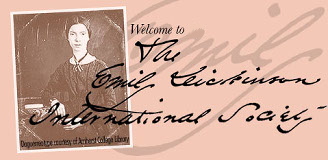Chanting to Paradise
Emily Dickinson, Music and Citizenship
Nicole Panizza
Doctor of Music graduand, Royal College of Music, London (U.K)
Senior Lecturer in Music Performance, Coventry University (U.K)
nicolepanizza@gmail.com/ npanizza@rcm.ac.uk
ab1907@coventry.ac.uk
Dickinson’s poetry is famously musical. In shaping her prosody she drew heavily on the rhythmic and other musical structures of liturgical and, most specifically, hymn-based material. As well as her use of specific musical sources there is a conscious use of music in Dickinson’s poetry both as a source of imagery and as a strategy for shaping her terse, condensed poetic line. Music is both the ground on which the superstructure of her poetic thought was built and a condition of being towards which it aspired.
There has been much discussion and debate relating to Emily Dickinson’s life, poems, letters of correspondence and the various musical settings of these. However, surprisingly little study has been done into the broad pool of musical settings to be found in her own personal music folio. Indeed, it can be argued that Dickinson’s experiments in lyric form were primarily based on music she both made herself and was immersed in.
Having learnt the piano to the high level that she did and being well versed in the popular musical genres of her day, Dickinson was ideally placed to play many different kinds of music. These included Civil War songs, dance tunes, minstrel songs, sentimental ballads, Irish, English and Scottish folk song and transcriptions of Western classical favourites from the opera and concert stage that she admired. Piano works included compositions by Schumann, Mozart, Beethoven, Czerny and Bertini.
Building on a diverse selection of compositions sourced directly from Emily Dickinson’s own music folio (Houghton Library, Harvard University) our performance will examine the works which nourished and informed her own musical sensibility. The featured songs and instrumental pieces not only provide an opportunity to observe a diverse assortment of nineteenth century European and American music but also examine the above points with a view to challenging and appraising existing interdisciplinary approaches to Dickinson’s life and work.
It is our wish that this recital will demonstrate how Dickinson moved effortlessly from “New England citizen” to “world citizen” via her engagement with composers from many corners of the globe. Most importantly it will establish a new forum for the way in which we “hear” and “perform” the musical works that moved, engaged and inspired Emily Dickinson.
Nicole Panizza (piano) and Jane Sheldon (soprano)
